The Character of Cricket Read online
Page 4
Sussex were batting. It was grey but warm and showed signs of lifting. Thomson, the once terrifying ‘Thommo’ who used to partner the fearsome Lillee, was bowling up the hill. The ground slopes quite dramatically down from the north towards the sea. From my position it looked as if Thommo was bowling in a newly permed grey wig but advancing years had certainly not slowed him to military medium. I had only been watching a few minutes when the Sussex captain, Barclay, the dominant figure in a last-wicket partnership inching slowly closer to the Australian first innings score of 321, appeared to duck straight into a Thomson ball which rose quite sharply from short of a length. There was a terrible crack of leather on bone and the wounded batsman went into a whirling dervish routine before sinking to his knees somewhere around fine leg.
The spectator on my right, middle-aged, in blazer and blue espadrilles, sucked his teeth and shook his head as the fielders gathered round.
‘Part of the game innit,’ said his neighbour, tweed jacketed, plastic bag of lunch at his feet.
It was all rather unexpected. The pitch had looked quite placid; Barclay was chugging away comfortably and was on 37 not out. But now here he was retiring hurt and being carted off to hospital for stitches to his mouth. ‘An ordinary bouncer as opposed to a wicked one’ was the Times’s verdict, which was rather what I thought though it all looks very different when you’re sitting on a deck chair several yards on the safe side of the mid-wicket boundary.
I took advantage of the lull to go and seek out Ossie Osborne. Mr Osborne is the Honorary Librarian of the Sussex County Club and what he doesn’t know about Sussex cricket is not worth knowing. A keen club cricketer in his youth, he retired when he was sixty-four, but still runs Brighton Brunswick, the local mid-week club side which plays its home games on the county ground. For fifty years he worked for Joe Lyons and his finest achievements were for them. When Lyons gave him a special anniversary dinner they quoted two of his finest hours on the anniversary menu:
‘On Sunday 31 July 1927 Harold Osborne playing against a Wembley Special Constables XI took all ten wickets for 33 runs and then scored 53 not out.’
And, almost better:
‘Osborne helped restore the position being last out, another Constantine victim, for 67. The West Indian fast bowler finishing with 6 for 58.’
Sixty-seven against Learie Constantine! Learie used to enjoy playing at the Lyons’ ground at Sudbury. There were a hundred and twenty acres and a fine club-house. In the evening after the matches there were dances in the club-house. Very good parties.
Mr Osborne is known to everyone as Ossie. Indeed the nickname is so widely accepted that even on the Brighton Brunswick fixture card he is down as Match Manager for the game against Malden Wanderers as ‘Ossie’. Despite the advancing years he is extremely perky and talks incessantly, punctuating his speech with occasional apologies for talking so much and also with frequent ‘God Bless You’s. I wasn’t surprised to learn that latterly he was a wicket-keeper. I bet he appealed a lot.
‘I’m not a reader,’ he says, ‘but I do like research.’
When he took the job on he became infatuated – his own word – with the archives and records in his care. In the winters he took everything home and solemnly compiled a card index system which means that now every single person who ever played for Sussex since 1790 has his own card, written out in Ossie’s hand.
‘I’ll tell you a story,’ said Ossie. ‘A chap writes to me from Australia and says he wants to know more about someone who played Sheffield Shield cricket and also played for Sussex. His name was E.B. Dwyer.’ At this point Ossie went to his card index and got down Dwyer’s entry. It turned out that he wasn’t just plain ‘E.B.’, he was ‘J.E.B.B.P.Q.C.’, full name John Elicius Benedict Bernard Placid Quirk Carrington Dwyer. A goodish bowler, Dwyer took 179 wickets for the county between 1904 and 1909, including sixteen in a single match against Middlesex at Hove in 1906.
He came to Sussex because when Pelham Warner took his MCC side to Australia Dwyer played against it for a relatively minor team and evidently impressed Plum Warner. ‘Well bowled,’ said Plum. ‘You must come and play in England.’
Dwyer took Warner at his word and took ship to England but, of course, there was no one there to meet him, and certainly not Plum Warner. Somewhat discouraged he still managed to scrounge a game in which C.B. Fry, then Sussex captain, was playing. ‘Well bowled,’ said Fry, after the game. ‘Come down to Sussex and we’ll have a look at you.’ And he had a net and became a Sussex regular.
‘Now read on,’ said Ossie. I read. ‘J.E.B.B.P.Q.C.’ was, it transpired, the great-grandson of Michael Dwyer, the Wicklow chieftain, who had led the Insurrection of 1798 and been transported to Australia. That’s where all those names came from.
There was a shout from outside. Ossie turned and stared out at the arena. ‘Hilditch caught by Greggy,’ he said. ‘He won’t like that.’ The Australian vice-captain had been the victim of an unlucky decision in the first innings and was taking time to get among the runs.
Ossie always takes an early lunch but he let me stay in his library while he was away. He locked me in, mind you, which was a touch unnerving as the library is in a stand which feels distinctly combustible.
It’s full of history. The earliest record of cricket in the county is from 1622, when four boys were reported to the vicar of Boxgrove near Chichester for playing cricket during evening prayer time. The club was founded in 1839 in convivial circumstances (like most cricket clubs) after dinner at the Old Ship. ‘Most gladly received by all the lovers of this truly English and noble game’ ran the contemporary report. The annual sub was a couple of guineas, and ‘The club shall engage one or more men to bowl for two or more days in the week, for practice.’
Almost as interesting – almost as interesting as the commemorative album of the Installation of H.H. Maharajah Ranjitsinhji Jam Sahib of Nawanagar on 11 March 1907 – was a letter from Neville Cardus on Manchester Guardian paper twenty years later. It is obviously in answer to a fan letter from young Osborne. ‘Your handwriting does not reveal your name,’ wrote Cardus, ‘else I would address you “Dear Mr...”. Your charming letter has refreshed me. Keep up your enthusiasm for the Great Game. It is one of the country’s finest possessions. Write to me as frequently as you like. With good wishes yours sincerely, Neville Cardus.’
I felt rather abashed by this, because I had recently been less than enthusiastic about a collection of Cardus which I had reviewed in The Times. I felt the reputation was inflated, too much of the prose too whimsically florid, and I sensed also that perhaps he wasn’t altogether a very nice person. Yet here was an extraordinarily generous response to an unknown admirer. Delusions of grandeur and overwork prevent most people from answering letters nearly so enthusiastically – if at all.
I soon realised why Ossie took his lunch early. As soon as he came back the players went off for their lunch and the little library became crowded with extraordinary cricket buffs. They were all after little bits of esoterica, but the one who most intrigued me was a man of thirty-odd who came in with a large scorebook filled in with what I took to be his own handwriting. ‘I’ve got a problem,’ he said. ‘I’m an over missing for this game in 1952.’ And he pointed to the match in question, every single ball of it neatly filled in. So Ossie went down, rather creakily, on his hands and knees and got out the 1952 scorebooks. The cricket buff frowned and pored over the pages and tried to work out why and how such a discrepancy had arisen.
Mesmerised though he is by the records and the stories, Ossie seemed quite unmoved by the actual cricket going on outside his window. When Keppler Wessels of Australia was run out by Parker he paused for a moment and said reflectively: ‘Wessels ought to know better than that. He knows Paul inside out.’ This was because Wessels, a South African, used to play for Sussex. Indeed he is a sort of lineal descendant of J.E.B.B.P.Q.C. Dwyer himself. But most of the time Ossie doesn’t watch. Over his shoulder I could see an Australian – Greg Ritchi
e, I later discovered – launching himself into a handsome attack on the Sussex bowlers.
Ossie used to watch more when his old friend Jack Hobbs was alive. Hobbs retired to Hove and had a regular seat in the pavilion, though if someone else sat in it he was too modest to complain.
‘Greggy’s coming tomorrow,’ said Ossie, talking of Tony.
‘Popular round here is he?’ I asked waspishly, thinking of Packer and the Establishment view of Greig as villain.
‘He is with me,’ said Ossie belligerently. When Greig was in the wilderness Ossie got him to turn out for Brighton Brunswick. He still has one of Greig’s bats and his old blazer which he still sometimes wears when he goes out to the middle to toss a ceremonial coin. It makes him look like a very small scarecrow, a dwarf in giant’s clothing, and he has a stiff imitation Wurzel Gummidge walk to add humour to the act.
De Selincourt has a passage about the County Ground at Hove in his book The Game of the Season. ‘The County Club,’ he wrote, ‘in which we all take a fierce personal pride is not an aloof place of grandeur on to whose grounds we occasionally creep to watch real class cricket and creep away again, feeling very small and foolish, to our antics on the village green. Not a bit of it. It is in a very real sense the parent club; and we go to Hove or Horsham with our heads up, at our ease and welcomed, to watch and appreciate the finer points of the great game, which are not to be seen with such frequency in our own brighter, shorter and less skilful battles.’
A man in a white floppy sun hat slept that afternoon in a deck chair on the grassy slope at the North End; and, because the sun had disposed of the grey misty morning one or two had stripped to the waist and were sitting with their feet on the bench in front. In the back garden of one of the villas to the east two elderly men and a woman sat absorbed behind a makeshift windbreak of striped canvas. ‘God Bless,’ said Ossie as he said good-bye, and I was reminded of another passage from de Selincourt’s book:
‘Unostentatiously and surely, with no high-sounding talk or pulling of long, earnest faces, something is generated which takes off from cricket to the even greater game of living and that something is the spirit of active goodwill, the finest and most precious thing in life.’
Sentimental creatures, the cricket writers of the Golden Age, and yet they had their points. And even they would have enjoyed Ritchie’s century and Phillips’s ninety as they set the home team more than 300 to win on the final day.
I walked back along the promenade to Brighton. Fishermen sat lugubriously by their rods, young girls soaked up a far from scorching sun in bikinis, and I bought four sticks of pink-and-white Brighton rock for my children. Behind me in the distance was a separate index card for every Sussex cricketer who ever lived, and the county was slowly fighting its way to a draw.
St. Helen’s, Swansea
I wanted to stay with Mrs Evans but the St Helen’s Guest House was full. All along the Mumbles Road the ‘No Vacancies’ signs were up in the windows along with the net curtains and the cacti. No Vacancy at the Allanton; No Vacancy at the Oyster; No Vacancy at the Marine Vista nor the Bay View nor the Seychelle nor the Tudor Court. So I stayed in the centre of Swansea at the Dolphin, which was dull and about five times the price and in a modern shopping centre complex of concrete and dried blood brick redeemed only by an authentically pompous statue of Sir H. Hussey Vivian Bt, first Baron Swansea of Singleton, luminous green with verdigris.
Swansea is one of the two main homes of the Glamorgan County Cricket Club, otherwise known as Clwb Criced Morgannwg. The County Ground is in Cardiff but I feel Swansea is the real home. In Cardiff the rugger people turfed the cricketers off the Arms Park in 1967, breaking the tradition and the continuity. Since then Glamorgan have played their Cardiff games in Sophia Gardens. In Swansea they coexist with the rugger players just as they always have since 1921 when Glamorgan cricket first became first class.
You can’t get away from rugby in South Wales any more than you can escape from the Welshness of the Welsh. My mother’s maiden name is Vaughan, which suggests a smidgen of Welsh blood, but the Welsh still feel foreign to me. Charming, mind – if you meet them half way, that is – but foreign all the same.
On the Red Dragon, which is what they call the six o’clock from Paddington once it crosses the border of the Principality, there was an attractive blonde in a white dress sitting next to a man with frizzy hair. She was certainly a singer and he, I think, a conductor, and I like to believe they were on their way to an Eistedffod. North of the Severn she began to sing on the crowded train, in Welsh. Newport. Cardiff. Bridgend. Neath. Rugby towns all. ‘Isn’t it lovely to be back in the mountains?’ asked an old woman of her dog, or maybe the rest of us, as we snaked into Swansea. Surely they couldn’t play cricket here, I thought. As well play cricket in the Pyrenees.
I knew I was wrong, of course. I knew that Wales used to play MCC in the old, old days and that S.F. Barnes once opened the bowling for them in such a match when he was fifty-seven years old. Funny sort of Welshman. I knew from that day’s paper that the national team were in the process of beating Zimbabwe in – of all places – Builth Wells, though I hadn’t realised that Glamorgan players can’t play for Wales. Those registered for the county are available for England instead. Hence the Welsh captain of England, Tony Lewis, who also captained Glamorgan’s championship-winning side in 1969. Hence also Gilbert Parkhouse, who played for England in the fifties and opened the batting for Glamorgan in the summer and played full-back for Swansea in the winter.
Today the opposition was Leicester, whom I had already seen looking a little plain at Trent Bridge. This time they were again without Gower, on duty for the Third Test, but Willey, dropped by England, was back as their star all-rounder.
I knew about Welsh cricket because I had once interviewed the legendary Wilfred Wooller, who captained the side that won the championship in ’48 and who was secretary until 1977. I checked the date of my interview and found it was 1970 – just after the Archbishop of Wales had threatened to resign his Glamorgan membership if the South African cricket tour went ahead. Mr Wooller said the Archbishop was being ‘unchristian’, which was a characteristic Woollerism. They still talk a lot about ‘Wilf’ in South Wales. He played rugby and squash for Wales and was centre-forward for Cardiff City, and he gave the impression of being permanently in search of an argument. Some people call him ‘Dyed in the Wooller’.
So I knew about Welsh cricket, but I had never seen it happen. And I knew about St Helen’s, the Swansea ground, partly because it is where Swansea plays its rugger, partly because it is so close to the sea, and partly because it was here that Gary Sobers once hit poor Malcolm Nash for thirty-six runs in one over.
To get to it you walk along the Mumbles road going west. Odd that ‘Mumbles’ seems to be almost the only word in bilingual Wales that requires no translation. Not like Neudd y Sir, which means County Hall, that massive new affair on the sea front – all concrete and smoked glass; nor Multi-Storey Car Park, which is Parc Ceir Aml-Lawr. There is no Welsh translation of the 1952 Prison Act, either. You can read it at the entrance to the gaol opposite County Hall. ‘It is an offence for any person,’ it begins, ‘to help a prisoner to escape.’
The ground itself is just after the Guild Hall, which I mistook from the distance for a power station. They were holding a degree ceremony there: scrubbed young people in gowns and mortar-boards, mums in flowered hats, dads in Sunday suits, and much photography. You can see St Helen’s from afar because of the huge pylons supporting the floodlights. It was the only ground to stage a floodlit game against the Australian Rugby tourists but – oh, the shame of it – there was a power cut and the lights failed.
Just to the east of it is the Patti Pavilion, Swansea’s seaside theatre. Last week it had been A Viennese Whirl, with Angela Jenkins and John Noble; next was to be Edmund Hockridge, star of Carousel. To the south is the main road (noisy) and a strip of grass separating it from the beach (sandy) and the sea (busy). On the grass
are two war memorials and one to Swansea Jack, 1930-1937, ‘the brave retriever who saved twenty-seven human and two canine lives, loved and mourned by all dog lovers.’ I feel I should know more about Swansea Jack.
Behind the ground the hill rises steeply and the terraces are piled one on another like the terraces of Bath, except that these houses are predominantly grey with a few flashes of bright pastel where people have painted their pebbledash and created little oases of neapolitan ice cream. It crossed my mind that Dylan Thomas came from here and that perhaps one of those houses was number 5 Cwmdonkin Drive. Then I thought that the poet was probably not a cricket man, so instead I walked round to the Members’ Entrance opposite the Cricketers pub.
I was wrong, as it happens, about Dylan. When he was at school his headmaster caught him climbing over a wall and asked what he was up to. With customary frankness the boy said he was bored with class and thought he might pop down to St Helen’s and watch Glamorgan at cricket.
‘Dylan,’ said the head, ‘That is very wrong of you. Very wrong indeed.’ And then as he walked away, he half turned and called out: ‘I hope someone catches you.’
I was an hour or so early for the start of play and was surprised to find that a net had been erected in the centre of the field and the Glamorgan players were practising on the wicket they had used in the previous day’s county match. Common practice, I was told later, especially if the players have performed badly the day before – which in this case they had.
I say ‘centre’ of the field, but this is inaccurate. George Clement, some time groundsman at St Helen’s, said with that characteristic Welsh verbal felicity that if I were to fly up a few hundred feet and look down I would see that the ground was like ‘a giant light bulb’. Norman Yardley once wrote that it was like a key-hole. The narrow, westerly end is where the rugby is played. Indeed the scoreboard at that end still said ‘Opponents – Barbarians’. It is flanked on the sea side by an imposing old grandstand which, in the wake of the Bradford disaster, was having £100,000 spent on improvements to it. The pneumatic drills were going full blast before play, but the workmen promised they would stop at eleven. In any case no one sits in it during cricket unless it is impossibly hot. This seldom happens at Swansea but if it does the rugby stand is the only place with any shade. All other seats are open to the elements.

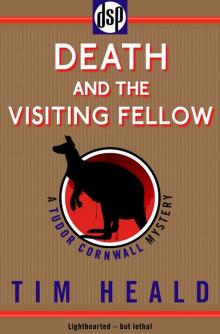 Death and the Visiting Fellow
Death and the Visiting Fellow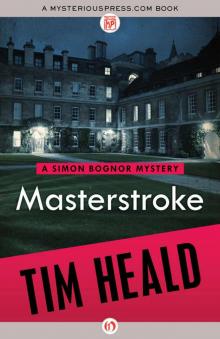 Masterstroke (The Simon Bognor Mysteries)
Masterstroke (The Simon Bognor Mysteries) Deadline (The Simon Bognor Mysteries)
Deadline (The Simon Bognor Mysteries)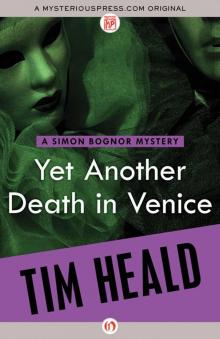 Yet Another Death in Venice (The Simon Bognor Mysteries)
Yet Another Death in Venice (The Simon Bognor Mysteries)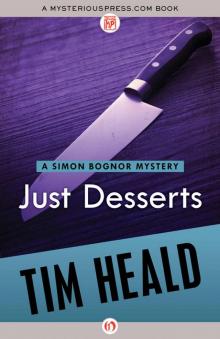 Just Desserts (The Simon Bognor Mysteries)
Just Desserts (The Simon Bognor Mysteries)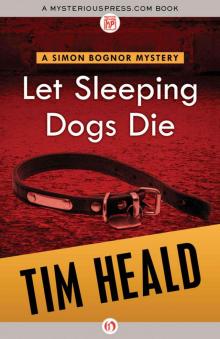 Let Sleeping Dogs Die (The Simon Bognor Mysteries)
Let Sleeping Dogs Die (The Simon Bognor Mysteries)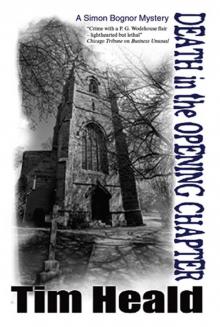 Death in the Opening Chapter
Death in the Opening Chapter Blue Blood Will Out (The Simon Bognor Mysteries)
Blue Blood Will Out (The Simon Bognor Mysteries)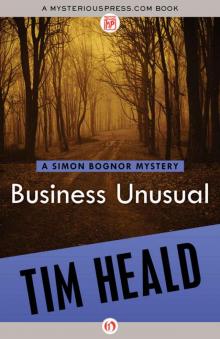 Business Unusual (The Simon Bognor Mysteries)
Business Unusual (The Simon Bognor Mysteries)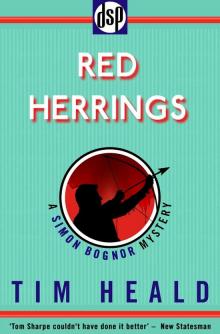 Red Herrings
Red Herrings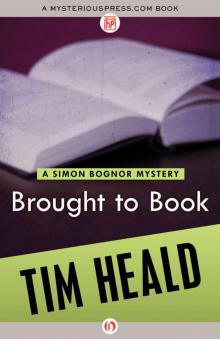 Brought to Book (The Simon Bognor Mysteries)
Brought to Book (The Simon Bognor Mysteries)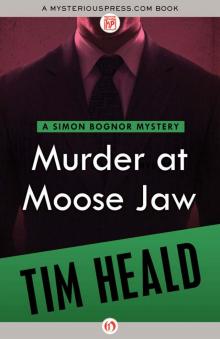 Murder at Moose Jaw (The Simon Bognor Mysteries)
Murder at Moose Jaw (The Simon Bognor Mysteries)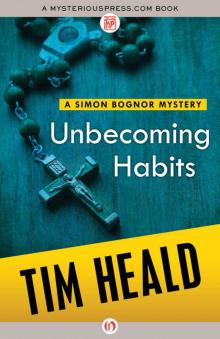 Unbecoming Habits (The Simon Bognor Mysteries Book 1)
Unbecoming Habits (The Simon Bognor Mysteries Book 1)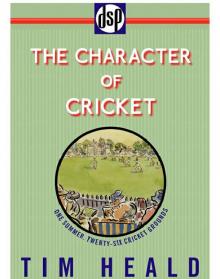 The Character of Cricket
The Character of Cricket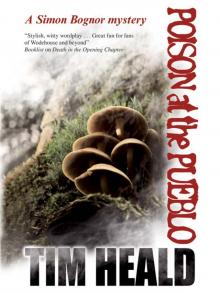 Poison At The Pueblo
Poison At The Pueblo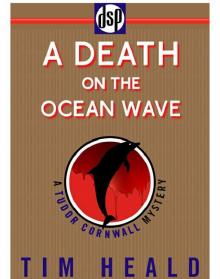 A Death on the Ocean Wave
A Death on the Ocean Wave